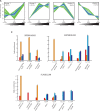Comparative Sperm Proteomics in Mouse Species with Divergent Mating Systems
- PMID: 28333336
- PMCID: PMC5435083
- DOI: 10.1093/molbev/msx084
Comparative Sperm Proteomics in Mouse Species with Divergent Mating Systems
Abstract
Sexual selection is the pervasive force underlying the dramatic divergence of sperm form and function. Although it has been demonstrated that testis gene expression evolves rapidly, exploration of the proteomic basis of sperm diversity is in its infancy. We have employed a whole-cell proteomics approach to characterize sperm divergence among closely related Mus species that experience different sperm competition regimes and exhibit pronounced variation in sperm energetics, motility and fertilization capacity. Interspecific comparisons revealed significant abundance differences amongst proteins involved in fertilization capacity, including those that govern sperm-zona pellucida interactions, axoneme components and metabolic proteins. Ancestral reconstruction of relative testis size suggests that the reduction of zona pellucida binding proteins and heavy-chain dyneins was associated with a relaxation in sperm competition in the M. musculus lineage. Additionally, the decreased reliance on ATP derived from glycolysis in high sperm competition species was reflected in abundance decreases in glycolytic proteins of the principle piece in M. spretus and M. spicilegus. Comparison of protein abundance and stage-specific testis expression revealed a significant correlation during spermatid development when dynamic morphological changes occur. Proteins underlying sperm diversification were also more likely to be subject to translational repression, suggesting that sperm composition is influenced by the evolution of translation control mechanisms. The identification of functionally coherent classes of proteins relating to sperm competition highlights the utility of evolutionary proteomic analyses and reveals that both intensified and relaxed sperm competition can have a pronounced impact on the molecular composition of the male gamete.
Keywords: acrosome; fertilization; oocyte; sperm competition; translation regulation; zona pellucida.
© The Author 2017. Published by Oxford University Press on behalf of the Society for Molecular Biology and Evolution.
Figures




Similar articles
-
Proteins involved in motility and sperm-egg interaction evolve more rapidly in mouse spermatozoa.PLoS One. 2014 Mar 7;9(3):e91302. doi: 10.1371/journal.pone.0091302. eCollection 2014. PLoS One. 2014. PMID: 24608277 Free PMC article.
-
Contrasting patterns of evolutionary constraint and novelty revealed by comparative sperm proteomic analysis in Lepidoptera.BMC Genomics. 2017 Dec 2;18(1):931. doi: 10.1186/s12864-017-4293-2. BMC Genomics. 2017. PMID: 29197336 Free PMC article.
-
New insights into the mechanisms of fertilization: comparison of the fertilization steps, composition, and structure of the zona pellucida between horses and pigs.Biol Reprod. 2009 Nov;81(5):856-70. doi: 10.1095/biolreprod.109.077651. Epub 2009 Jul 8. Biol Reprod. 2009. PMID: 19587333
-
Sperm competition and the evolution of spermatogenesis.Mol Hum Reprod. 2014 Dec;20(12):1169-79. doi: 10.1093/molehr/gau070. Epub 2014 Oct 16. Mol Hum Reprod. 2014. PMID: 25323971 Review.
-
Sperm competition and the evolution of gametic compatibility in externally fertilizing taxa.Mol Hum Reprod. 2014 Dec;20(12):1190-7. doi: 10.1093/molehr/gau069. Epub 2014 Oct 16. Mol Hum Reprod. 2014. PMID: 25323969 Review.
Cited by
-
Deactivation of the JNK Pathway by GSTP1 Is Essential to Maintain Sperm Functionality.Front Cell Dev Biol. 2021 Feb 25;9:627140. doi: 10.3389/fcell.2021.627140. eCollection 2021. Front Cell Dev Biol. 2021. PMID: 33732696 Free PMC article.
-
Molecular Evolution across Mouse Spermatogenesis.Mol Biol Evol. 2022 Feb 3;39(2):msac023. doi: 10.1093/molbev/msac023. Mol Biol Evol. 2022. PMID: 35099536 Free PMC article.
-
Genotype-by-environment interactions influence the composition of the Drosophila seminal proteome.Proc Biol Sci. 2023 Sep 13;290(2006):20231313. doi: 10.1098/rspb.2023.1313. Epub 2023 Sep 13. Proc Biol Sci. 2023. PMID: 37700651 Free PMC article.
-
iTRAQ-based proteomic analysis of sperm reveals candidate proteins that affect the quality of spermatozoa from boars on plateaus.Proteome Sci. 2021 Jul 30;19(1):9. doi: 10.1186/s12953-021-00177-9. Proteome Sci. 2021. PMID: 34330296 Free PMC article.
-
Pronounced Postmating Response in the Drosophila Female Reproductive Tract Fluid Proteome.Mol Cell Proteomics. 2021;20:100156. doi: 10.1016/j.mcpro.2021.100156. Epub 2021 Sep 29. Mol Cell Proteomics. 2021. PMID: 34597791 Free PMC article.
References
-
- Aitken RJ, Nixon B, Lin M, Koppers AJ, Lee YH, Baker MA.. 2007. Proteomic changes in mammalian spermatozoa during epididymal maturation. Asian J Androl. 9:554–564. - PubMed
-
- Baker MA, Hetherington L, Reeves G, Muller J, Aitken RJ.. 2008a. The rat sperm proteome characterized via IPG strip prefractionation and LC-MS/MS identification. Proteomics 8:2312–2321. - PubMed
-
- Baker MA, Hetherington L, Reeves GM, Aitken RJ.. 2008b. The mouse sperm proteome characterized via IPG strip prefractionation and LC-MS MS identification. Proteomics 8:1720–1730. - PubMed
-
- Bayram HL, Claydon AJ, Brownridge PJ, Hurst JL, Mileham A, Stockley P, Beynon RJ, Hammond DE.. 2016. Cross-species proteomics in analysis of mammalian sperm proteins. J Proteomics 135:38–50. - PubMed
Publication types
MeSH terms
Substances
LinkOut - more resources
Full Text Sources
Other Literature Sources
Molecular Biology Databases

